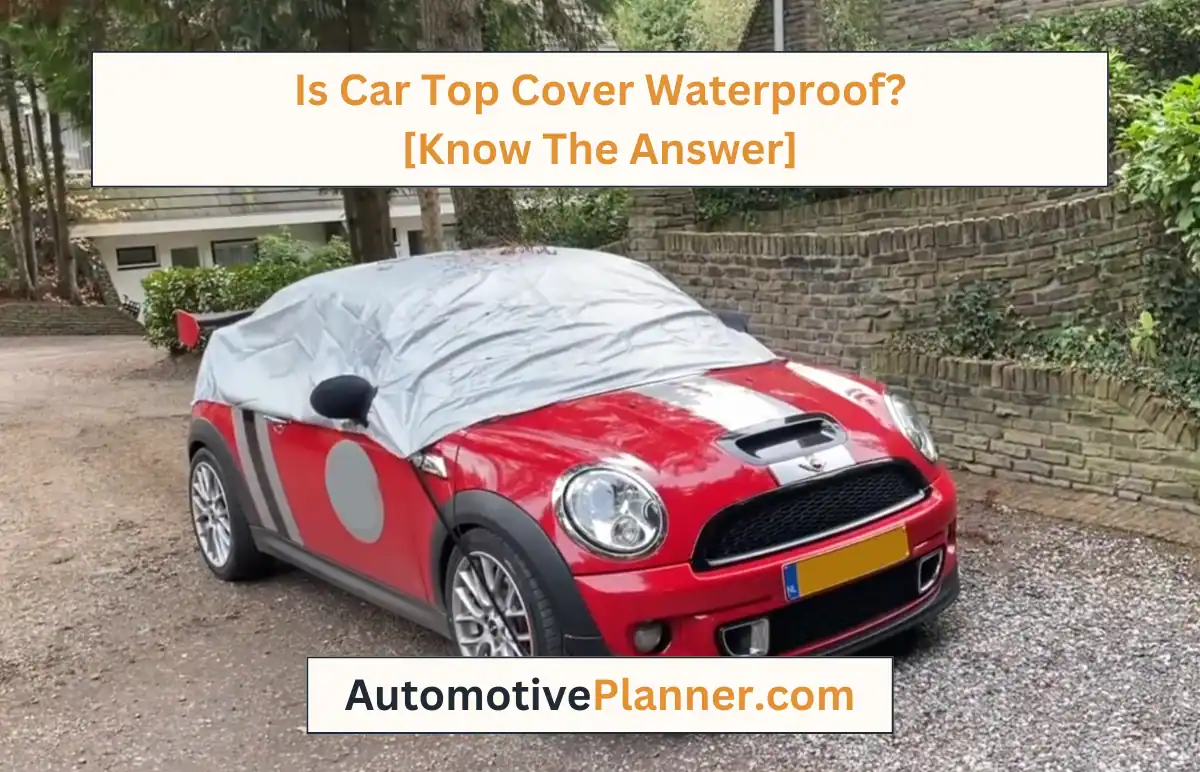Is Car Top Cover Waterproof? [Know The Answer]
To ensure optimal vehicle protection, it is imperative to consider whether a car top cover is waterproof. The answer holds the key to shielding your cherished automobile from the unpredictable whims of weather.
Car top covers are typically designed to be waterproof. They are crafted from materials like polyester or nylon with waterproof coatings to shield your vehicle from rain, snow, and other environmental elements. This waterproof feature ensures the car remains protected from moisture.
Here, you will also find different materials used in the car cover. The knowledge and methods will help you find everything in the car top cover that will help you select the best cover. Read the whole article and benefit from it.
How To Know If The Car Top Cover Is Waterproof: 8 Different Ways
Ensuring that your car top cover is waterproof is crucial to protect your vehicle from the elements. A waterproof cover shields your car from rain, snow, and other environmental factors that can damage its exterior.
Here are eight step-by-step ways to determine if your vehicle top cover is indeed waterproof:
Way 1: Check The Product Label
Look for labels or tags on the cover packaging or within the product information. Manufacturers often prominently mention if the cover is waterproof. Phrases like “water-resistant” or “waterproof” should be clearly stated.
Way 2: Review Product Specifications
Consult the product specifications provided by the manufacturer. Visit the official website or refer to the user manual that accompanies the cover. Waterproof materials like polyester with special coatings or laminations are often listed.
Way 3: Inspect The Material Quality
Physically examine the cover’s material. Manufacturers typically craft waterproof covers from materials featuring a waterproof coating, such as polyurethane or PVC. A high-quality, tightly woven fabric can also indicate water resistance.
Way 4: Seam Quality Matters
Pay attention to the seams of the cover. Waterproof covers often have sealed or taped seams to prevent water penetration. If the seams are well-constructed and packed, it’s a good indicator of waterproofing.
Way 5: Perform A Water Test
Conduct a simple water test by placing the cover on an easily cleaned or dried surface. Pour a small amount of water onto the cover and observe if it beads up and rolls off, indicating water repellency.
Way 6:Absence Of Ventilation Holes
Waterproof covers usually lack ventilation holes. These holes are standard in water-resistant covers to prevent condensation. A cover without ventilation holes may indicate a design offering complete waterproof protection.
Way 7: Look For Certification
Some covers may come with industry-standard certifications. Check for labels like “IPX” ratings, indicating the water resistance degree. Higher IPX ratings generally mean better protection against water.
Way 8: Read User Reviews
Check online reviews from other car owners who have purchased the same cover. Their experiences can provide valuable insights into the cover’s performance, including its effectiveness in protecting against water.
7 Types Of Waterproof Materials Used In Car Top Covers:
Choosing the suitable material for your car cover is crucial to ensure adequate protection against the elements. Various materials offer different levels of durability and water resistance.
Here are seven types of waterproof materials commonly used in car covers, each with unique properties.
1. Polyester With Polyurethane Coating:
A popular choice for waterproof car covers, polyester with a polyurethane coating provides a durable and robust solution. This combination offers excellent water resistance, safeguarding your vehicle from weather conditions.
2. Vinyl:
Vinyl, renowned for its durability and waterproof characteristics, is commonly used as a heavy-duty material in robust car covers. It is a reliable shield against rain and snow, protecting your car in adverse weather.
3. Nylon With PVC Coating:
Nylon and a polyvinyl chloride (PVC) coating form a waterproof barrier ideal for all-weather car covers. This material combination provides adequate protection against rain and other environmental factors.
4. Microfiber With Waterproof Membrane:
Microfiber materials featuring integrated waterproof membranes balance softness and water resistance. This option is suitable for those seeking both comfort and reliable vehicle protection.
5. Canvas With Water-Repellent Treatment:
Canvas covers treated with water-repellent solutions offer a breathable yet waterproof alternative. This material choice ensures adequate protection, allowing air circulation and preventing moisture buildup.
6. Polyethylene:
Lightweight and budget-friendly, polyethylene is a waterproof material often used in entry-level car covers. While providing essential water resistance, it remains a cost-effective solution for those on a budget.
7. Oxford Fabric With PU Coating:
Oxford fabric, treated with polyurethane (PU) coating, combines enhanced water resistance with durability. This material is well-suited for car covers that must withstand varying weather conditions.
5 Tips For Enhancing Water Resistance In Car Top Covers:
Ensuring optimal water resistance in your car top cover protects your vehicle from the elements. From material selection to maintenance practices, here are five elaborate tips to enhance the water resistance of your car cover and keep your truck shielded and well-preserved.
Tip 1: Opt For Sealed Seams:
Ensure your car cover features sealed seams or taped seams. This prevents water infiltration through stitching, fortifying overall water resistance and enhancing protection.
Tip 2: Use A Car Cover Support System
Invest in a support system, such as a frame or tension cables, to elevate the car cover. This prevents water pooling, promoting runoff and reducing the risk of leaks through vulnerable areas.
Tip 3: Choose A Custom-Fit Cover
Choose a custom-fit cover designed specifically for your car model. A well-fitted cover provides better coverage, minimizing gaps where water could seep.
Tip 4: Avoid Prolonged Exposure To Sunlight
Excessive exposure to sunlight can degrade water-resistant coatings. Park your car in shaded areas or use additional shade structures to minimize prolonged exposure.
Tip 5: Consider A Secondary Waterproofing Spray
Explore the use of secondary waterproofing sprays or solutions designed for specific materials. Apply these products as directed to enhance the water resistance of your car cover and extend its protective capabilities.
Related Questions:
How Does A Waterproof Car Top Cover Safeguard Against Environmental Elements?
A waterproof car top cover protects against environmental elements by forming a protective barrier. These polyesters are covered with polyurethane coating or vinyl, effectively repelling water thereby preventing rain and snow from reaching the car’s surface.
This barrier safeguards against potential damage, including corrosion and paint erosion caused by prolonged exposure to moisture.
The cover’s ability to resist water ensures the vehicle remains dry and protected, maintaining its aesthetic appeal and structural integrity in diverse weather conditions.
Why Is It Important To Use A Waterproof Car Top Cover?
A waterproof car top cover is crucial for preserving your vehicle’s exterior and longevity. The cover is a protective shield, preventing rain, snow, and other environmental elements from reaching the car’s surface. This safeguards against potential damage, including rust, corrosion, and paint erosion.
Moreover, a waterproof cover shields the interior from moisture, preventing mold and mildew growth. Investing in such a cover ensures that your vehicle remains in optimal condition, reducing the need for costly repairs and enhancing its overall resale value.
Are All Car Top Covers Waterproof, Or Do I Need To Look For That Feature Specifically?
Not all car top covers are inherently waterproof, and looking for this feature is essential. While some covers offer basic protection against dust and debris, proper waterproofing requires polyester with polyurethane, vinyl, or nylon with PVC coating.
Waterproof covers provide an additional defense against rain, snow, and moisture, preventing potential damage to your vehicle’s exterior and interior.
Therefore, if water resistance is a priority, selecting a car cover explicitly designed and labeled as waterproof for comprehensive protection is crucial.
How Do Waterproof Car Top Covers Protect Vehicles From Various Weather Conditions?
Waterproof car top covers are a formidable barrier against diverse weather conditions by preventing moisture infiltration. Crafted from polyester with polyurethane coating or vinyl, these covers repel rain, snow, and moisture, safeguarding vehicles from potential damage. The waterproof layer ensures that water beads off, preventing it from reaching the car’s surface.
This protection is essential in thwarting issues like rust, corrosion, and paint damage caused by prolonged exposure to rain.
These covers provide a comprehensive defense against environmental pollutants, preserving a vehicle’s aesthetic and structural integrity.
What Are The Key Factors To Consider When Choosing A Waterproof Car Top Cover?
When selecting a waterproof car top cover, a key factor is the material’s quality, such as polyester with polyurethane coating or vinyl, ensuring adequate water resistance. Opt for covers with sealed seams, preventing water infiltration. Custom-fit covers tailored to your car model provide better coverage.
Regularly applying water-repellent treatments enhances longevity, and a support system prevents water pooling.
Additionally, assess the cover’s durability, breathability, and ease of maintenance. Prioritize reputable brands and consider user reviews for insights into real-world performance.
Are There Any Limitations To The Effectiveness Of Waterproof Car Top Covers?
Waterproof car top covers have limitations. Prolonged exposure to harsh weather and sunlight can degrade their effectiveness over time. In extreme and persistent heavy rainfall, no cover can guarantee absolute waterproofing. Regular maintenance is crucial, as neglect or infrequent cleaning can compromise the cover’s performance.
Despite these limitations, a well-maintained waterproof cover remains valuable for protecting your vehicle against most environmental elements and preserving its condition.
Conclusion:
Hope, you know if Is car top cover waterproof or not. Thorough research and selection are imperative. Choosing materials like polyester with polyurethane coating or vinyl enhances water resistance.
Regular maintenance and occasional water-repellent treatments further fortify the cover’s effectiveness against the elements. By prioritizing quality and adopting proactive measures, a well-informed decision ensures that the car top cover meets the waterproof criteria.








